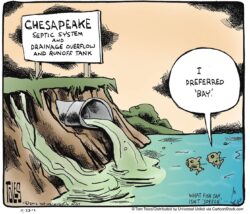Our Bizarre Obsession with Shitting into Drinking Water
This blog is from Katie Allen a WaterWISER PhD researcher working at the University of Leeds on ecological sanitation and the recycling of human feces to land for food production.
“The present water closet system, with all its boasted advantages, is the worst that can generally be adopted, briefly because it is a most extravagant method of converting a molehill into a mountain. It merely removes the bulk of our excreta from our houses to choke our rivers with foul deposits and rot at our neighbors’ door. It introduces into our houses a most deadly enemy.”
Quote - Chemist quoted in the Scientific American in 1869 (Cutler & Miller, 2005)
I ask that you indulge me 5 minutes of your time to call out the frankly mindboggling concept that is sanitary sewers; something many of you probably consider completely normal, and the thought of not having one completely unimaginable.
Firstly, just take a moment to consider the sheer complexity and cost required to connect every single toilet to a pipe, and every one of those pipes to a network of bigger pipes buried underneath a town or city. Now let’s pray that we don’t need to make any repairs or live in an earthquake prone area (Kang, et al., 2013).
Next, each one of those toilets must also be connected to a piped water supply network, so that’s another set of pipes required. Not to mention the huge dams and reservoirs required to bring water to urban areas, which are expensive and often sources of conflict (Narain, 2002).

Pic of sewer into bay
All this infrastructure so that the user can press a button to quickly remove the repugnant turd that they just created from their sights, along with 5-10 litres of pristine, drinking-quality water. It is then whooshed away down this sewer rollercoaster, hoping to reach a treatment plant.
Sewer systems are built to protect public health, but when they are badly managed they can become the health hazard. An estimated 1-13% of sewage is lost to leakage along the way (Rutsch, et al., 2006), and 61% of homes are connected to sewers which are not connected to any form of treatment (Baum, et al., 2013)). Mixing a small amount of shit with a large amount of water serves only to magnify the feces management problem. Not only do we now have an enormous quantity of water to deal with, which can overwhelm the sewer network and treatment plants, but we now also have contaminants in a very mobile form. Water doesn’t like to stay put; it travels far, it travels fast, and it likes to flow into ground and surface water (Reynolds & Barrett, 2007). Preventing contamination of water sources is already difficult and expensive enough, without also purposefully defecating into it.
But, let’s assume for arguments sake that your lucky turd makes it safely to a functioning treatment plant. Now comes the challenge of un-mixing the mixture we just mixed, and it turns out that once mixed together, feces and water are quite difficult to un-mix; to the tune of billions of dollars and billions of kilowatt-hours (Gandiglio, et al., 2017). And what are we left with? Slightly less clean water than we started with, and still a pile of turd-filled sludge that needs dealing with.
Humans are the only land animals that intentionally defecate in water, because clean water is arguably the most vital resource for survival. We cannot live without it, and less than 1% of all water on planet earth is available for us to drink. And yet purposefully contaminating billions of litres of drinking water with the >1 billion tonnes of shit we produce every day, whilst at the same time 2.2 billion people lack safely managed water services (WHO & UNICEF, 2023), is ecologically, economically and socially mindless. We need to change our water toilet culture and keep feces and water separate.
(P.S. Please stop flushing away urine. It’s 95% water and great for fertilising plants. If you take only one, implementable action away from this chapter let it be to stop flushing wees and start peeing in the shower.)
---
Baum, R., Luh, J. & Bartram, J., 2013. Sanitation: A Global Estimate of Sewerage Connections withoutTreatment and the Resulting Impact on MDG Progress. Environmental Science & Technology, Volume 47, pp. 1994-2000.
Cutler, D. & Miller, G., 2005. The role of public health improvements in health advances: The twentieth-century United States. Demography, Volume 42, pp. 1-22.
Gandiglio, M. et al., 2017. Enhancing the Energy Efficiency of Wastewater Treatment Plants through Co-digestion and Fuel Cell Systems. Frontiers in Environmental Science, Volume 5, p. 70.
Kang, G., Tobita, T. & Iai, S., 2013. Damage to sewerage systems during the 2004 Earthquake in Niigata-ken Chuetsu, Japan. Engineering Geology, Volume 164, pp. 230-242.
Narain, S., 2002. The flush toilet is ecologically mindless, s.l.: Down to Earth.
Reynolds, J. H. & Barrett, M. H., 2007. A review of the effects of sewer leakage on groundwater quality. Water and Environment Journal, 17(1), pp. 34-39.
Rutsch, M., Rieckermann, J. & Krebs, P., 2006. Quantification of sewer leakage: A review. Water Science & Technology, 54(6-7), pp. 135-144.
WHO & UNICEF, 2023. Progress on Household Drinking Water, Sanitation and Hygiene 2000-2022 - Special focus on gender, New York: World Health Organisation (WHO) and United Nations Children's Fund (UNICEF).
